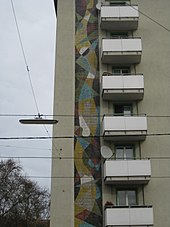Harold Reitterer
Harold Reitterer (born February 13, 1902 in Vienna , † October 23, 1987 in Maurach am Achensee ) was an Austrian painter .
Life
Harold Reitterer was born in Vienna in 1902 as the son of Anglist Theodor Reitterer. As a high school student he was already creating watercolors and portraits, after graduating from high school in 1920 he made his first attempts at abstract painting and drawing. From 1921 he studied at the Academy of Fine Arts Vienna for three years in the general painting school with Hans Tichy and one year with Karl Sterrer . At the same time he worked with Franz Wiegele in Nötsch and attended evening courses for metal driving in copper and brass with Oskar Thiede . In 1925 he graduated from the academy with a teaching qualification test for freehand drawing at secondary schools, after the probationary year he taught at various Viennese secondary schools .
From 1925 to 1929 he continued to study at the Academy of Fine Arts. He attended the special school for painting with Rudolf Bacher , which he graduated as an academic painter. From 1930 he was represented with works in the Vienna Künstlerhaus , the Secession and the Albertina . In 1934 he received the academy's sponsorship award. In 1935/36 he worked as a portraitist for the English nobility in Eton , Windsor and Ascot , where he was influenced by English portrait painters and their watercolor technique.
In 1943 he had to work in the Wehrmacht as a driver and English interpreter, but was dismissed after eight months due to physical complaints. In 1946 he and Robin C. Andersen received an order for tapestries from the British Council . Until 1950 he worked as a drawing professor in Vienna, in 1951 he moved to Maurach am Achensee, where he lived until his death. For health reasons he was given temporary retirement in 1952 and permanent retirement in 1954, and from then on worked as a freelance artist. He was a member of the Vienna Artists 'House and the Tyrolean Artists' Association .
Reitterer's work includes oil paintings and watercolors as well as facade designs in the form of frescoes , sgraffiti and mosaics . His works show a clear structure in area and space and a tendency towards abstraction and geometry of the objects, without becoming completely non-representational.
Awards
- Golden Laurel of the Austrian Society of Fine Artists , 1954
- Silver Medal of Honor for Services to the Republic of Austria , 1983
Works
- Wall painting at the Pillberg elementary school , around 1951
- Sgraffito on the staircase walls and a sculpture of the Pied Piper of Hameln on the school servant's house, elementary school Kufstein- Sparchen , 1954
- Wall painting on the west facade of the elementary school and kindergarten in Kufstein- Zell , 1954
- Sgraffito at the Kitzbühel post office , 1955 (not preserved)
- Sgraffito at the Tyrolean Health Insurance Fund, Lienz , 1955
- Mosaic ornament at the Max-Wopenka-Hof, Vienna- Simmering , 1955/56
- Sgraffito seasonal customs on the facade of the Schwendau - Hippach elementary school , 1958
- Wall painting on the south facade of the Aschau elementary school in the Zillertal , 1960
- Wall painting at the commercial vocational school in Kitzbühel, 1965
- Mural on the north facade of the Maurach am Achensee kindergarten, 1967
- Painting in the entrance area of the Jenbach post office , 1967
- Facade painting at the Kirchbichl secondary school , 1971
- Wall painting at the Söll kindergarten , 1971
- Design of the Marienkirche in Maurach am Achensee, 1983
literature
- Gert Ammann: In love with nature. Harold Reitterer 1902 - 1987. In: Heimatblätter - Schwazer Kulturzeitschrift No. 68, 2010, pp. 4–28 ( PDF; 3.2 MB )
Web links
Individual evidence
- ^ Pillberg elementary school. In: Tyrolean art register . Retrieved October 10, 2017 .
- ↑ Fingernagel-Grüll, Wiesauer: Art in building on public buildings: building sculpture Pied Piper of Hameln. In: Tyrolean art register . Retrieved October 10, 2017 .
- ^ Wiener Wohnen: Max-Wopenka-Hof
- ↑ Baumann, Wiesauer: Art in building on public buildings: Sgraffito seasonal customs. In: Tyrolean art register . Retrieved October 10, 2017 .
| personal data | |
|---|---|
| SURNAME | Reitterer, Harold |
| BRIEF DESCRIPTION | Austrian painter |
| DATE OF BIRTH | February 13, 1902 |
| PLACE OF BIRTH | Vienna |
| DATE OF DEATH | October 23, 1987 |
| Place of death | Maurach am Achensee |
